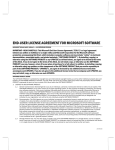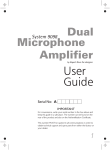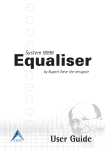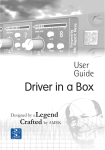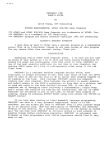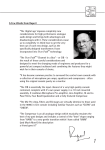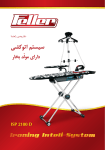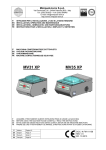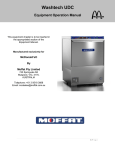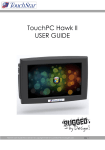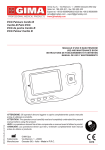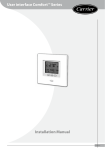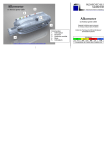Download RNCL User Guide Issue3
Transcript
System 9098 Compressor Limiter by Rupert Neve the designer User Guide Serial No: A IMPORTANT For convenience, write your serial number in the box above and keep this guide in a safe place. The number can be found on the rear of the product and also on the Authentification Certificate. This number MUST be quoted in all communications in order to obtain technical support and spare parts from either the factory or your dealer. 1 © Harman International Industries Ltd. 1997 All rights reserved. Parts of the design of this product may be protected by worldwide patents. AMEK is a trading division of Harman International Industries Ltd. Information contained in this manual is subject to change without notice and does not represent a commitment on the part of the vendor. AMEK shall not be liable for any loss or damage whatsoever arising from the use of information or any error contained in this manual or through any mis-operation or fault in hardware or software contained in the product. No part of this manual may be reproduced, stored in a retrieval system, transmitted in any form or by any means, electronic, electrical, mechanical, optical, chemical, including photocopying and recording, for any purpose whatsoever without the express written permission of AMEK. It is recommended that all maintenance and service on the product should be carried out by AMEK or it's authorised agents. AMEK cannot accept any liability whatsoever for any loss or damage caused by service, maintenance or repair by unauthorised personnel. Part No: MANRNCL 2 Issue 3 Harman International Industries Ltd Langley House Third Avenue Trafford Park Manchester M17 1FG United Kingdom Tel: +44 (0) 161 868 2400 Fax: +44 (0) 161 873 8010 E-mail: [email protected] Web: www.amek.com Contents Unpacking Safety Installation Audio Connections Overview Block Diagram Operational Guide Specifications Warranty 4 Safety symbols Earthing Changing the fuse 5 Mains Cable 100V/220V operation 7 Location Rack mounting Power up and clicks Cleaning 10 11 by Rupert Neve 12 15 Compressor Controls 16 Limiter Controls 18 Ambience 19 Meter Controls 21 Master Controls 10dB Pad ST Link 22 23 24 3 Unpacking Check List The following items are included with the product. It is recommended that packaging materials are retained until all expected items are accounted for and found to be operating correctly. Carton Packet containing: 4 off M6 mounting screws 4 off plastic washers 1 off fuse for 110V operation. Moulded IEC mains lead Quality Certificate Compressor/Limiter User Guide Protective foam materials 4 IMPORTANT SAFETY INSTRUCTIONS Safety Caution For your own safety and to avoid invalidation of warranty, all text marked with these Safety Symbols should be read carefully! Please keep this information! Important information. Read this before proceeding. Caution Hazards or unsafe practices which can result in severe personal injury or death. Warning Hazards or unsafe practices which can result in minor personal injury or product or property damage. Important Please read this manual carefully before connecting this apparatus to the mains for the first time! Obey the following safety instructions. Read and understand these instructions before operating the apparatus or doing troubleshooting, testing, adjustments or repairs. Failure to comply with the safety instructions may result in personal injury. CAUTION RISK OF ELECTRIC SHOCK DO NOT OPEN ! Caution - Earthing This apparatus MUST be earthed. Under no circumstances should the mains earth be disconnected from the mains lead. Caution - Changing the Fuse To avoid the risk of fire replace only with same value and type of fuse as marked on the unit, 500mA T (220V) or 1A T (100V). Fuses are 20mm antisurge, IEC type. Before changing the fuse, always switch off the unit and remove the AC power cable! Locate the flap above the IEC connector and open it using a small screwdriver. Fit the appropriate fuse supplied in the fixings pack and close the flap. 5 Safety WARNING - For your own safety and to avoid invalidation of the warranty please read this section carefully. ! ! ! ! ! ! ! ! ! ! ! ! ! ! ! 6 Do not place the apparatus on an unstable surface. Do not insert objects through any apertures. Do not use this apparatus near water. Unplug the unit before cleaning. Clean only with a damp cloth. Do not block any of the ventilation openings. Install in accordance with the manufacturer's instructions. Do not install near any heat sources such as radiators, heat registers, stoves or other apparatus including amplifiers or power supplies that produce heat. Do not defeat the safety purpose of the polarised or grounding-type plug. A polarised plug has two blades with one wider than the other. A grounding-type plug has two blades and a third grounding prong. The wider blade or the third prong are provided for your safety. When the plug provided does not fit into your outlet, consult an electrician for replacement of the obsolete outlet. Protect the power cord from being walked on or pinched particularly at plugs, convenience receptacles and the point where they exit from the apparatus. Avoid using mains outlets on the same circuits as air control systems or other equipment that regularly switches on and off. Only use attachments /accessories specified by the manufacturer. Unplug this apparatus during lightning storms or when unused for long periods of time. Refer all servicing to qualified service personnel. Servicing is required when the apparatus has been damaged in any way such as the power supply cord or plug is damaged liquid has been spilled or objects have fallen into the apparatus the apparatus has been exposed to rain or moisture the apparatus does not operate normally the apparatus has been dropped. Unplug the unit under these circumstances. Adjust only those controls that are covered by the operating instructions. Use only the mains lead provided with the equipment . Other leads may not have sufficient current rating. Do not operate this unit with the cover removed. IMPORTANT SAFETY INSTRUCTIONS Mains Cable The supplied IEC mains cable must be terminated correctly to the AC mains supply before use. Use only an approved AC plug or power distribution device. The three cores are colour coded as follows: Green/Yellow Brown Blue = = = Safety Earth Live Neutral The Green/Yellow core in the mains cable is a safety ground and must be connected at all times! 100V/220V Operation Before adjusting the operating voltage, always switch off the unit and remove the AC power cable! Locate the flap above the IEC connector and open it using a small screwdriver. Remove the barrel and replace it so that the correct voltage marking is outermost, then close the flap. The new voltage setting should be visible through the window. Fit the appropriate fuse supplied in the fixings pack. 7 Sécurité Précaution Pour votre sécurité et afin de ne pas interrompre la garantie il est important de lire attentivement les paragraphes marqués d'un symbole! Conserver ce document! Importante information. Priere de lire avant utilisation. Avis Dangers ou pratiques dangereuses pouvant résulter en des blessures graves ou causant la mort. Avertissement Dangers ou pratiques dangereuses pouvant résulter en blessures personnelles mineures légères ou en dommages à la propriété. Important Ce manuel est à lire attentivement avant de brancher cet appareil pour la première fois! Suivre les instructions de sécurité. Lire et comprendre ces intructions avant l'utilisation de l'appareil ou avant dépannage, essai, ajustement ou réparation. Ne pas se conformer aux instructions de sécurité peut provoquer de graves blessures. AVIS RISQUE DE CHOC ELECTRIQUE NE PAS OUVRIR ! Avis - Terre Cet appareil DOIT être mis à la terre. La mise à terre ne doit pas être débranchée du terminal principal sous acune circonstance. Avis - Changer le Fusible 8 Afin d'éviter un risque de feu, remplacer seulement avec fusible de la meme valeur et type tel qu'indiqué sur l'appareil, 500mA T (220V) ou 1A T (100V). Les fusibles sont de type IEC 20mm protection-surtension (pour fusibles). Avant de changer le fusible, éteindre l'appareil et enlever la prise d'alimentation! Localisez le battement au-dessus du connecteur IEC et ouvrez-le utiliser un petit tournevis. Allez parfaitement le fusible approprié fourni dans le paquet des accessoires et fermez le battement. INSTRUCTIONS DE SÉCURITÉ IMPORTANTES Cable de Secteur Le cable de secteur IEC fourni doit être correctement au cable d'alimentation avant l'utilisation. Protéger le cordon d'alimentation afin d'éviter qu'il soit piétiné, écrasé ou pincé, en particulier au niveau des prises de courant, des fiches femelles et des points de sorties de l'appareil. Utiliser seulement une prise de courant conforme. Les 3 cables à l'intérieur du cable d'alimentation sont de couleurs suivantes: Vert/Jaune Marron Bleu = = = Prise de Terre Phase Neutre Le cable vert/jaune à l'intérieur du cable d'alimentation est la sécurité terre et doit être toujours connecté! 100V/220V Fonctionnement Avant le réglage du voltage, toujours éteindre et débrancher l'appareil! Localisez le battement au-dessus du connecteur IEC et ouvrez-le utiliser un petit tournevis. Enlevez le baril et replacez-le afin que le voltage marquer correct est le plus à l'extérieur, alors fermez le battement. Les nouveaux voltage mettre devrait être visible à travers la fenêtre. Allez parfaitement le fusible approprié fourni dans le paquet des accessoires. 9 Installation Location This product is designed and screened to minimise internal electromagnetic emissions and provide immunity to external electromagnetic fields. To reduce the risk of performance degradation due to external interference, do not site this unit close to sources of strong magnetic fields such as power supplies, power amplifiers, loudspeakers etc. Rack Mounting This product is designed to be rack mounted using the screws and washers supplied to help preserve the finish of the facia panel. The facia graphic layer is under-surface printed to provide a robust hard wearing surface designed to last the life of the product in virtually any operating environment. Failure to use the supplied fixings may result in damage to the facia surface which can invalidate the warranty. It is recommended that additional rack-mount side supports are used in conjunction with the facia panel fixings, particularly when the unit is mounted in a flite case or vehicle where vibration and transit shocks can be expected. Powering up and Clicks Clicks may be heard from in/out switches when the product is powered up, these will dissipate after approximately 10 minutes. This is perfectly normal. Cleaning Unplug the unit before cleaning. The product should be cleaned with a soft brush around the controls. If the facia becomes dirty, use a damp cloth with a little household soap to remove the dirt. DO NOT use solvent cleaners under any circumstances or the facia may be permanently damaged and warranty invalidated! 10 Audio Connections Earth Link The CHASSIS GROUND post is internally connected to both the case and the safety earth. If the link is removed for technical reasons (such as earth loops), then the ANALOGUE GROUND post must be wired separately to the installation technical earth point. Audio Connections Two identical sets of 3 pin XLR connectors are provided for each compressor channel A and B. Inputs are female, outputs are male. All connectors follow the European wiring convention: Pin 1 = Screen Pin 2 = Hot (+) Pin 3 = Cold (-) The main inputs and outputs are transformer balanced, the outputs coupled using Rupert Neve's "tertiary feedback" output stage design. The side chain inputs and outputs are electronically balanced using Rupert's "TLA" transformer-like-amplifier design. System Level Switch Each compressor channel is fitted with a switch to change the system operating level between +4dBu and -10dBv as required. System levels can be changed independently allowing the unit to be operated as two separate mono compressor/limiters or as a stereo pair. 11 Overview by Rupert Neve Each section of the RNCL has a compressor and a limiter which can be adjusted independently of each other. The following discussion describes the behaviour of compressors and limiters and the purpose of each type of control. Compression For signals below a "certain" level, compressors provides a linear path allowing these signals to pass without the gain being processed in any way. Once these signals exceed that "certain" level, the gain is reduced in a controlled manner. The amount of gain reduction depends on two variables, ratio and threshold. 1:1 +25 +20 OUTPUT LEVEL (dBu) Ratio To describe "ratio" we will assume that the threshold remains fixed. The gain reduction applied can be either gentle or more severe. The most gentle, of course, is no reduction at all and this occurs if the ratio is set at 1:1. The ratio is sometime referred to as the "slope" as shown on the graph. This shows how the output level varies with input level at different ratio settings. The threshold is set at 0dBu. +15 2:1 +10 5:1 +5 16:1 0 -5 -10 -15 -20 -20 -15 -10 -5 0 +5 +10 +15 +20 +25 INPUT LEVEL (dBu) Gain reduction (compression) is the difference between what the output level would be without compression and the actual output. On the graph it is the distance between the 1:1 line and output for that input level. Signals are reduced in a logarithmic manner i.e. the reduction is based on dBs, not voltages. 12 A signal which is 10dB above the threshold on a compressor with a 5:1 ratio will be reduced in level so that it is only 2dB above the threshold at the output. With a fixed threshold, the amount of gain reduction increases with higher ratio settings. +25 OUTPUT LEVEL (dBu) Threshold The other major variable is the amount by which the signal exceeds a "threshold". The illustration shows how the output level varies with input level for different threshold settings. The ratio is set at 5:1. For a given ratio, the amount of gain reduction increases with lower threshold settings. +20 +20 dBu +15 +15 dBu +10 +10 dBu +5 +5 dBu 0 0 dBu -5 -10 Release Time -15 The diagrams can show how the compressor handles -20 -20 -15 -10 signals of constant amplitude, such as pure tones. Real programme signals however, continually change in level and the compressor can be required to respond in a variety of ways. All ratios (slopes) 5:1 -5 0 +5 +10 +15 +20 +25 INPUT LEVEL (dBu) For example, consider a programme with fairly constant level but which contains a short loud "bang". It's likely that a compressor would be required to reduce the level of the "bang". Once the "bang" has passed, the compressor should stop compressing and allow the signal to pass without being reduced. If we expect the "bang" to be a short one, it would be preferable for the compressor to stop compressing quite quickly. This is termed a "short release time". If we now consider a signal which has regular high level pulses (such as a heavy rhythmic bass line) and if this signal passes through a compressor with a short release time, the gain will return to normal after every bass note. This can create an unpleasant effect called "pumping" in which the level of all the other instruments is forced up and down by the compressor between each bass note. Setting a slower release time causes the gain reduction to remain in effect between each bass note and the "pumping" is reduced. Average Level This latter example also shows that until the music ends, the gain will remain reduced by a certain amount. It can therefore be useful to have some additional gain available to compensate for this reduction. Using compression together with "make up" gain has the effect of increasing the average level of the programme signal which makes the material sound "louder". 13 Overview Attack Time The compressor "attack" control adjusts the rate at which it begins to compress. If it is set to a short time (fast attack), gain changes occur quickly. Slower attack times mean that gain reduction hardly occurs at all before the transient has passed. Typical programme material contains transients ("spikes") which may cause gain reduction to occur. Some of these transients will be extremely fast and have very little effect on the sound of the signal. Setting a long attack time means that virtually no gain reduction occurs because the transient has passed before compression has had time to build up. Limiting Limiting also provides a form of compression but one with an extremely high and fixed ratio. The RNCL has a ratio of in excess of 100:1. As with the compressor, the point at which gain reduction occurs is variable. The limiter ratio is extremely high which means that the threshold is effectively the maximum level that can be output and is therefore labelled "level". The limiter behaviour is based on the "peak" value of the input signal, unlike the compressor which uses an RMS rectifier. A typical signal may benefit from compression beginning at a modest level and with a gentle slope. If the input level exceeds a second threshold, the limiter can prevent further output increases. The diagram shows typical curves that might be used. 14 +25 +20 OUTPUT LEVEL (dBu) Combining Compression and Limiting The RNCL has been designed to provide a flexible gain reduction tool. In many cases, a combination of compression and limiting can be useful. +15 Compressor threshold is -5 dBu, ratio 2:1 Limiter level is +6 dBu Limiting +10 +5 0 Compression -5 -10 -15 Linear -20 -20 -15 -10 -5 0 +5 +10 +15 +20 +25 INPUT LEVEL (dBu) Output Side Chain Input Gain Reduction Xlr 3M Xlr 3F Symbol key Side Chain Return TLA Input Line Transformer Input +4dBu -10dBv Meter Select Insert In +4dBu -10dBv TLA Output VU Meter RMS Detector Peak Detector Side Chain Send VCA +4dBu -10dBv Faceplate Controls A/D Transformer D/A CPU Background Processor Output D/A Ambience Block Diagram 15 Operational Guide Attack Threshold Adjusts the level setting at which gain reduction begins to occur. Changes the time over which compression begins to occur. Release Determines the time taken for gain reduction to stop being applied. Ratio Changes the severity of gain reduction once the signal exceeds the threshold setting. In Switches the compressor section into circuit. This is independent from the limiter section. Compressor Hard Knee Selects a different shape to the compression curve. When not selected, compression begins gradually as the signal exceeds the threshold. It only reaches the set ratio several dB above the threshold. Selecting Hard Knee makes the change less gradual. 16 Auto The release time can be made variable depending upon the signal causing the compression. Short term overloads will release quickly and long term overloads more slowly. Side Chain In Both channels of the RNCL use two audio paths. The primary path carries the input signal, passes it through the gain reduction device and provides the output. The secondary path receives the same input signal but processes it to determine the gain reduction to be applied. This path is called the "side chain". Compressor Selecting "Side Chain In" allows equalisers or delays to be inserted into the side chain which feeds the compressor. This means gain reduction can be frequency dependent. LF cut can be applied to the side chain to prevent a bass line "pumping" the overall signal level. Alternatively, HF boost can be applied which will make the compressor act more severely on high frequency signals. This can be used to "de-ess" over sibilant signals. 17 Operational Guide Level Sets the maximum signal level which passes through the limiter. Release Changes the time taken for gain reduction to return to zero after limiting. Fast Attack Selecting "fast" allows even short term transients to cause gain reduction. Limiter Output Gain Compression and limiting cause the output signal level to be reduced. In many cases, it is not the overall reduction in level which is required but a reduction of the difference between the high and low levels. The drop in output level can therefore be compensated for, using the output gain control. 18 The output gain control only affects the output when either limiting or compression is switched in. This means that the difference between the compressed and direct signal can be heard, without a serious change in the perceived volume. The output gain control also has a particular role when using the ambience mode. Ambience The ambience switch is a unique feature of the RNCL which allows background (ambient) noise to be reduced and is best understood by listening to it. When ambience is selected, the output signal is neither the compressed/limited signal nor the input signal, it is the difference between them. If controls are adjusted so that no gain reduction takes place, the input and the output signals are identical with the difference between them being zero. With "ambience" selected, the output will also be zero i.e. silence. Note that under some conditions, the phase of the signal passing through will be altered. Comp/Limiter For ambience mode to have any effect, the signal must undergo gain reduction using any combination of compression or limiting, therefore all the compressor/limiter controls influence the ambience effect. Adjusting the output gain changes the balance between the compressed/limited output and input signals and therefore has a major effect on the behaviour of ambience mode. 19 Operational Guide Applications A variety of special effects can be created using the ambience mode. One of the most useful is a reduction in the background audio that may be behind a "foreground" signal. The limiter mode can be used, but more gentle effects can be achieved using the compressor. Before switching to ambience mode, the compressor should be adjusted to give a modest degree of compression, perhaps peaking at around 10dB. For now, leave the output gain control at the centre (0) mark. Switch in the ambience mode and adjust the output gain control until a useful effect is obtained. The compressor characteristics can also be changed as required. Comp/Limiter With care, a form of gain reduction can be achieved which reduces the audio in the gaps between the main signal. This description could also apply to the behaviour of an expander or gate but it is important to note that ambience is not the same as either of these effects. 20 With the ambience effect, the degree of gain reduction is a function of the high level components of the input signal. The greater these are, the greater the degree of gain reduction (the more severe the compression when ambience is switched out). Expansion or gating, attenuates the signal path either by a preset amount or by an amount based on the low level components of the input. Gain reduction When selected to "G/R" the meter indicates '0' in the absence of an input signal or any gain reduction. If the signal exceeds the compression threshold or limit level, the amount of gain reduction is displayed. In ambience mode, the meter continues to show the amount of compression or limiting, but due to the nature of the ambience mode, no longer reads the reduction in the output signal level. Meters I/P The meter displays the input signal level and is calibrated to show '0' for signals of +4dBu. S/C O/P The output signal level is displayed. The calibration is the same as for reading input. S/C metering allows the input to the side chain XLR input to be displayed, whether "side chain" is selected or not. 21 Operational Guide 10dB Pad The meter pad reduces the reading of both A and B VU meters when in I/P, O/P or S/C modes. When enabled, meter readings are reduced by 10dB. '0' then represents +14dBu. Master Controls ST Link When enabled, identical gain reduction takes place in both A and B channel paths. Compression and/or limiting is selected for both paths at the same time and the characteristics for both paths are adjusted from the A path controls. The gain reduction applied is derived from whichever path has the greatest signal. 22 Specifications Noise - 150R source. Measured with RMS rectifier, 22Hz - 22kHz filter. No lim/comp in circuit Lim and/or comp. in circuit -100 dBu -92 dBu Frequency Response - measured from a 150R source and driving a 10K load. Compressor & limiter in circuit but no gain reduction 20Hz - 20kHz +/-0.2dB <10Hz and >120 kHz -3dB THD + Noise - 1kHz tone from a 150R source and driving a 10K load. +20dBu output - no comp/limiter in circuit +20dBu i/p compressed @ 3:1 to give +10dBu o/p +20dBu i/p limited to give +10dBu o/p 0.002% 0.03% 0.03% Crosstalk - One channel i/p @ +20dBu. Signal (w.r.t. +20dBu) measured at other output. better than 105dB at 20Hz and 1kHz better than 90dB at 20kHz Note: Figures apply whether or not limiting/compression is enabled. Mechanical - Dimensions and Weight Size 19" 2U rack unit. (482 x 89mm) Depth including connectors 420mm Weight 8.74kg Power Consumption 15W (typical) Notes 1. All specifications are subject to change without notice. 2. Figures quoted are measured on a normal production sample and typical of performance normally achieved, however, they do not constitute a guaranteed 23 Warranty 1. Amek is a trading division of Harman International Industries Ltd. End User means the person who first puts the equipment into regular operation. Dealer means the person other than Amek (if any) from whom the End User purchased the equipment, provided such a person is authorised for this purpose by Amek or it’s accredited Distributor. Equipment means the equipment supplied with this manual. 2. If within the period of twelve months from the date of delivery of the Equipment to the End User it shall prove defective by reason only of faulty materials and/or workmanship to such an extent that the effectiveness and/or usability thereof is materially affected, the Equipment or the defective component should be returned to the Dealer or to Amek and subject to the following conditions, the Dealer or Amek will repair or replace the defective components. Any components replaced will become the property of Amek. 3. Any Equipment or component returned will be at the risk of the End User whilst in transit (both to and from the Dealer or Amek) and postage/shipping must be prepaid. 4. This warranty shall only be available if: a) The Equipment has been properly installed in accordance with instructions contained in Amek’s manual; and b) The End User has notified Amek or the Dealer within 14 days of the defect appearing; and c) No persons other than the authorised representatives of Amek or the Dealer have effected any replacement of parts, maintenance adjustments or repairs to the Equipment; and d) The End User has used the Equipment only for such purposes as Amek recommends, with only such operating supplies as meet Amek’s specifications and otherwise in all respects in accordance with Amek’s recommendations. 5. Defects arising as a result of the following are not covered by this Warranty: Faulty or negligent handling, chemical or electro-chemical or electrical influences, accidental damage, Acts of God, neglect, deficiency in electrical power, air-conditioning or humidity control. 6. The benefit of this Warranty may not be assigned by the End User. 7. End Users who are consumers should note their rights under this Warranty are in addition to and do not affect any other rights to which they may be entitled against the seller of the Equipment. 24
























